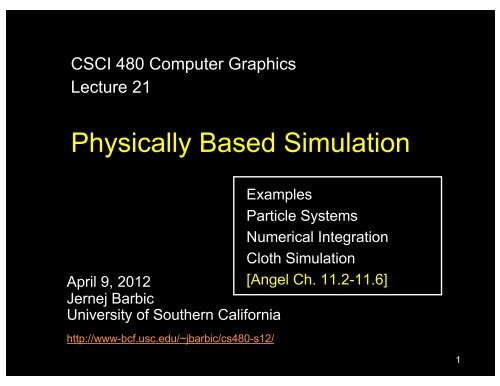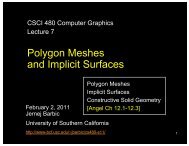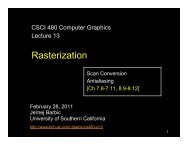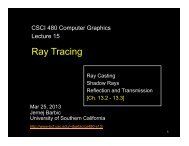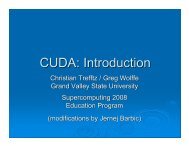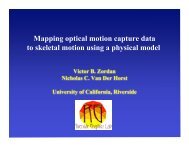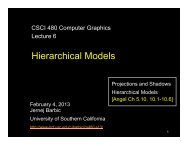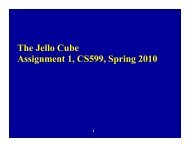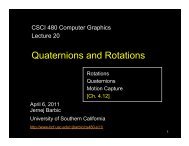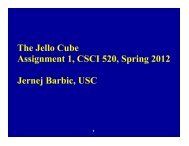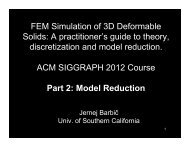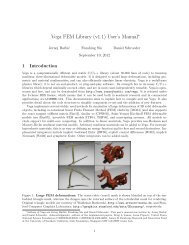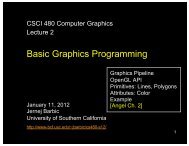Physically Based Simulation - University of Southern California
Physically Based Simulation - University of Southern California
Physically Based Simulation - University of Southern California
You also want an ePaper? Increase the reach of your titles
YUMPU automatically turns print PDFs into web optimized ePapers that Google loves.
CSCI 480 Computer Graphics<br />
Lecture 21<br />
<strong>Physically</strong> <strong>Based</strong> <strong>Simulation</strong><br />
Cloth <strong>Simulation</strong><br />
April 9, 2012<br />
[Angel Ch. 11.2-11.6]<br />
Jernej Barbic<br />
<strong>University</strong> <strong>of</strong> <strong>Southern</strong> <strong>California</strong><br />
http://www-bcf.usc.edu/~jbarbic/cs480-s12/<br />
Examples<br />
Particle Systems<br />
Numerical Integration<br />
1
Physics in Computer Graphics<br />
• Very common<br />
• Computer Animation, Modeling<br />
(computational mechanics)<br />
• Rendering (computational optics)<br />
2
Physics in Computer Animation<br />
• Fluids<br />
• Smoke<br />
• Deformable strands (rods)<br />
• Cloth<br />
• Solid 3D deformable objects .... and many more!<br />
3
Fluids<br />
Enright, Marschner,<br />
Fedkiw,<br />
SIGGRAPH 2002<br />
4
Fluids and Rigid Bodies [Carlson, Mucha, Turk,<br />
SIGGRAPH 2004]<br />
5
Fluids with Deformable Solid Coupling<br />
[Robinson-Mosher,<br />
Shinar,<br />
Gretarsson,<br />
Su, Fedkiw,<br />
SIGGRAPH 2008]<br />
6
Deformations<br />
[Barbic and James,<br />
SIGGRAPH 2005]<br />
7
Source:<br />
ACM SIGGRAPH<br />
Cloth<br />
8
[Bridson, Fedkiw,<br />
Anderson, ACM<br />
SIGGRAPH 2002<br />
Cloth (Robustness)<br />
9
Simulating Large Models<br />
[Doug James,<br />
PhD Thesis, UBC, 2001]<br />
10
Sound <strong>Simulation</strong> (Acoustics)<br />
[James, Barbic, Pai,<br />
SIGGRAPH 2006]<br />
11
Multibody Dynamics<br />
12
Multibody Dynamics +<br />
Self-collision Detection<br />
[Barbic and James, SIGGRAPH 2010]<br />
13
Physics in Games<br />
[Parker and James,<br />
Symposium on Computer Animation 2009]<br />
14
Haptic Interfaces<br />
• hap·tic ('hap-tik)<br />
adj.<br />
Of or relating to the sense <strong>of</strong><br />
touch; tactile.<br />
15
Surgical <strong>Simulation</strong><br />
[James and Pai,<br />
SIGGRAPH 2002]<br />
16
Offline Physics<br />
• Special effects (film, commercials)<br />
• Large models:<br />
millions <strong>of</strong> particles / tetrahedra / triangles<br />
• Use computationally expensive rendering<br />
(global illumination)<br />
• Impressive results<br />
• Many seconds <strong>of</strong> computation time per frame<br />
17
Real-time Physics<br />
• Interactive systems:<br />
computer games<br />
virtual medicine (surgical simulation)<br />
• Must be fast (30 fps, preferably 60 fps for games)<br />
Only a small fraction <strong>of</strong> CPU time devoted to<br />
physics!<br />
• Has to be stable, regardless <strong>of</strong> user input<br />
18
Particle System<br />
• Basic physical system in computer graphics<br />
• We have N particles<br />
• They interact with<br />
some forces<br />
• Fire, Smoke, Cloth, ...<br />
• Very popular for its simplicity<br />
[William Reeves,<br />
SIGGRAPH 1983]<br />
19
• Newton’s 2nd law:<br />
Newton’s Laws<br />
!<br />
F =<br />
!<br />
ma<br />
• Gives acceleration, given the force and mass<br />
• Newton’s 3rd law: If object A exerts a force F on<br />
object B, then object B is at the same time<br />
exerting force -F on A.<br />
!<br />
F !<br />
F !<br />
20
Case Study: Mass-spring Systems<br />
• Mass particles<br />
connected by<br />
elastic springs<br />
• One dimensional:<br />
rope, chain<br />
• Two dimensional:<br />
cloth, shells<br />
• Three dimensional:<br />
s<strong>of</strong>t bodies<br />
Source:Matthias Mueller, SIGGRAPH<br />
21
Single spring<br />
• Obeys the Hook’s law:<br />
F = k (x - x 0)<br />
• x 0 = rest length<br />
• k = spring elasticity<br />
(stiffness)<br />
• For xx 0, spring<br />
wants to contract<br />
22
Hook’s law in 3D<br />
• Assume A and B two mass points connected<br />
with a spring.<br />
• Let L be the vector pointing from B to A<br />
• Let R be the spring rest length<br />
• Then, the elastic force exerted on A is:<br />
!<br />
! ! L<br />
F =<br />
! k (| L | ! R)<br />
!<br />
Hook<br />
| L<br />
|<br />
23
Damping<br />
• Springs are not completely elastic<br />
• They absorb some <strong>of</strong> the energy and tend to<br />
decrease the velocity <strong>of</strong> the mass points attached to<br />
them<br />
• Damping force depends on the velocity:<br />
! !<br />
F =<br />
! k v d<br />
• k d = damping coefficient<br />
• k d different than k Hook !!<br />
24
A network <strong>of</strong> springs<br />
• Every mass point connected to<br />
some other points by springs<br />
• Springs exert forces<br />
on mass points<br />
– Hook’s force<br />
– Damping force<br />
• Other forces<br />
– External force field<br />
• Gravity<br />
• Electrical or magnetic force field<br />
– Collision force<br />
25
Network organization is critical<br />
• For stability, must organize the network <strong>of</strong><br />
springs in some clever way<br />
Basic network Stable network Network out<br />
<strong>of</strong> control<br />
26
Time Integration<br />
Source:Andy Witkin, SIGGRAPH<br />
Physics equation:<br />
x’ = f(x,t)<br />
x=x(t) is particle<br />
trajectory<br />
27
Euler Integration<br />
x(t + Δt) = x(t) + Δt f(x(t))<br />
Source:Andy Witkin, SIGGRAPH<br />
Simple,<br />
but inaccurate.<br />
Unstable with<br />
large timesteps.<br />
28
Inaccuracies with explicit Euler<br />
Gain energy<br />
Source:Andy Witkin, SIGGRAPH<br />
“Blow-up”<br />
29
Midpoint Method<br />
Source:Andy Witkin, SIGGRAPH<br />
Improves stability<br />
1. Compute Euler step<br />
Δx = Δt f(x, t)<br />
2. Evaluate f at the midpoint<br />
f mid = f((x+Δx)/2, (t+Δt)/2)<br />
3. Take a step using the<br />
midpoint value<br />
x(t+ Δt) = x(t) + Δt f mid<br />
30
Many more methods<br />
• Runge-Kutta (4th order and higher orders)<br />
• Implicit methods<br />
– sometimes unconditionally stable<br />
– very popular (e.g., cloth simulations)<br />
– a lot <strong>of</strong> damping with large timesteps<br />
• Symplectic methods<br />
– exactly preserve energy, angular momentum and/or<br />
other physical quantities<br />
– Symplectic Euler<br />
31
Cloth <strong>Simulation</strong><br />
• Cloth Forces<br />
- Stretch<br />
- Shear<br />
- Bend<br />
• Many methods are<br />
a more advanced version<br />
<strong>of</strong> a mass-spring system<br />
• Derivatives <strong>of</strong> Forces<br />
– necessary for stability<br />
[Baraff and Witkin,<br />
SIGGRAPH 1998]<br />
32
Challenges<br />
• Complex Formulas<br />
• Large Matrices<br />
• Stability<br />
• Collapsing triangles<br />
• Self-collision detection<br />
[Govindaraju et al. 2005]<br />
33
Self-collisions: definition<br />
Deformable model is<br />
self-colliding iff<br />
there exist non-neighboring<br />
intersecting triangles.<br />
34
Bounding volume hierarchies<br />
AABBs<br />
Level 1<br />
AABBs<br />
Level 3<br />
[Hubbard 1995]<br />
[Gottschalk et al. 1996]<br />
[van den Bergen 1997]<br />
[Bridson et al. 2002]<br />
[Teschner et al. 2002]<br />
[Govindaraju et al. 2005]<br />
35
Bounding volume hierarchy<br />
root root<br />
36
Bounding volume hierarchy<br />
v<br />
w v w<br />
37
Real-time cloth simulation<br />
Model Triangles FPS<br />
% Forces +<br />
Stiffness<br />
Matrix<br />
% Solver<br />
Curtain 2400 25 67 33<br />
Source:<br />
Andy Pierce<br />
38
Multithreading implementation<br />
Source:<br />
Andy Pierce<br />
39
Summary<br />
• Examples <strong>of</strong> physically based<br />
simulation<br />
• Particle Systems<br />
• Numerical Integration<br />
• Cloth <strong>Simulation</strong><br />
40


